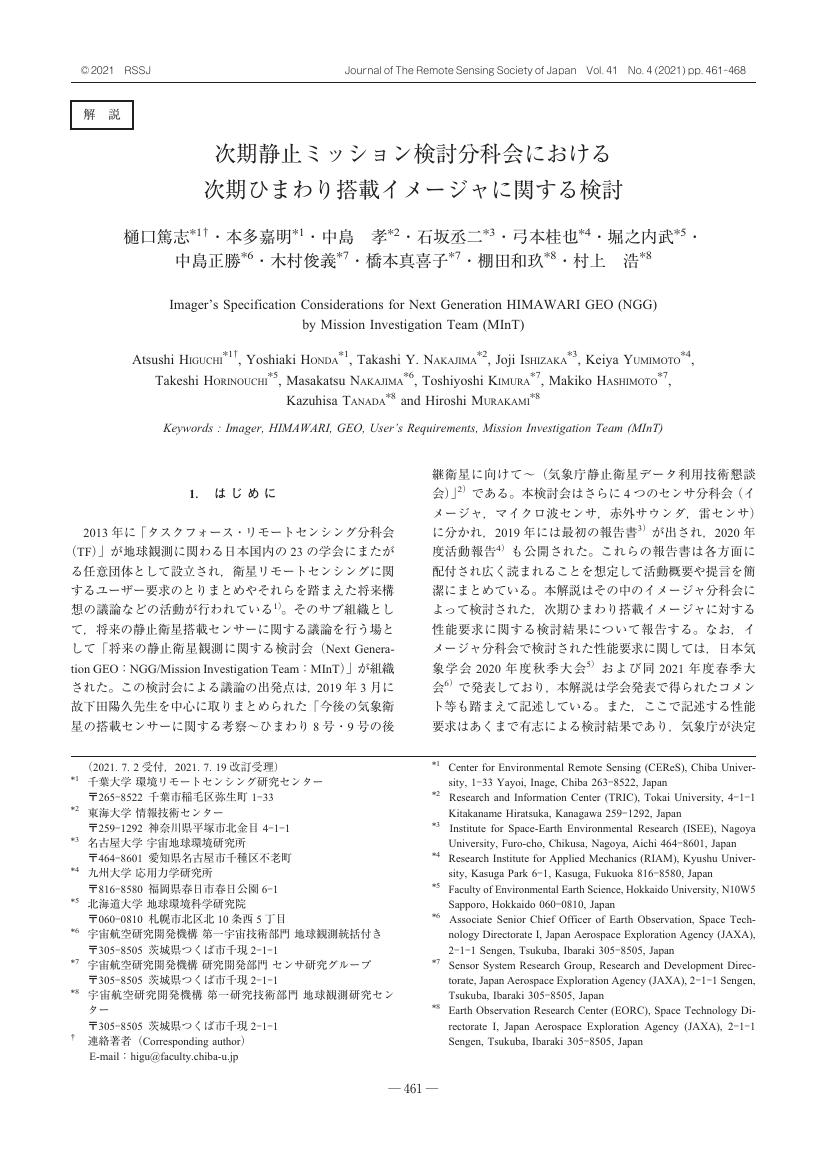1 0 0 0 OA 静止軌道からの大型分割望遠鏡による高時間中空間分解能地球観測
- 著者
- 木村 俊義
- 出版者
- 一般社団法人 日本リモートセンシング学会
- 雑誌
- 日本リモートセンシング学会誌 (ISSN:02897911)
- 巻号頁・発行日
- vol.41, no.2, pp.282-286, 2021-05-15 (Released:2021-08-25)
- 参考文献数
- 3
- 被引用文献数
- 1
In the history of Japanese Earth-observation satellites, technical improvements have made it possible to obtain images approximately 100 times finer than those of 40 years ago. This means that even geostationary orbit satellites, which are 60 times farther away than ordinary sun-synchronous low-orbit satellites, could now be capable of useful spatial resolution. With this in mind, the Japan Aerospace Exploration Agency (JAXA) seeks to achieve high temporal resolution image acquisition with useful spatial resolution. The new high temporal resolution satellite images are expected to be used for disasters, agriculture, coastal management, forest management, etc. For this purpose, JAXA has taken on the challenge to develop a geostationary satellite with a large segmented telescope. The main mirror will have a diameter of 3.6 m and will use the active optics technique, which will yield a ground resolution of approximately 7 m with a 100-km2 field of view at nadir. It will be equipped with 7 bands from visible to near-infrared, plus one thermal infrared band. A one-segment mirror subsystem proto-model with actuator and sensor is under production and evaluation as the key technology for the large segmented telescope. An all-electric propulsion satellite bus system is under consideration as a means of supporting the heavy weight of the telescope. Additional factors that are also currently under study include adding to the propulsion system, quick pointing ability, pointing stability, precise pointing determination, and the establishment of a ground station to maintain a latency of 30 minutes for image acquisition and delivery.
1 0 0 0 OA 次期静止ミッション検討分科会における次期ひまわり搭載イメージャに関する検討
- 著者
- 樋口 篤志 本多 嘉明 中島 孝 石坂 丞二 弓本 桂也 堀之内 武 中島 正勝 木村 俊義 橋本 真喜子 棚田 和玖 村上 浩
- 出版者
- 一般社団法人 日本リモートセンシング学会
- 雑誌
- 日本リモートセンシング学会誌 (ISSN:02897911)
- 巻号頁・発行日
- vol.41, no.4, pp.461-468, 2021-09-20 (Released:2022-01-13)
- 参考文献数
- 49
- 著者
- 片山 晴善 酒井 理人 加藤 恵理 中島 康裕 木村 俊義 中右 浩二
- 出版者
- 一般社団法人 映像情報メディア学会
- 雑誌
- 映像情報メディア学会技術報告 39.5 (ISSN:13426893)
- 巻号頁・発行日
- pp.19-26, 2015-01-26 (Released:2017-09-22)
我々は、非冷却赤外検出器を応用した宇宙用赤外イメージャーの実証センサとして地球観測用小型赤外カメラ(Compact Infrared Camera: CIRC)を開発してきた。CIRCの主要目的は,東南アジア諸国やシベリアなどで頻発する森林火災の検知、火山観測、都市部のヒートアイランド現象の把握である。本稿では平成26年5月24日に打ち上げられた「だいち2号」に搭載のCIRCについてその概要と地上試験、および軌道上の性能評価結果等を紹介する。
